The electric field is the area around an electric charge where another charge experiences a force. A magnetic field is an area around a magnetic pole in which the magnetic material experience a force.
The term field is defined as the existing force experienced between two objects in a specified space without physical contact. A field is commonly illustrated by lines of force around the objects experiencing this effect.
Depending on the type of quantity, there are two types of fields as follows:
- Electric field
- Magnetic field
In the early 1850s, James Clark Maxwell formed equations to illustrate how the electric and magnetic fields are interrelated to each other. In this article, we will observe and analyze the differences between the electric and magnetic fields based on the study of electromagnetism. Additionally, a short description of electric and magnetic fields has been added for your reference.
What is Electric Field?
Technically, an Electric Field is defined as the force experienced by a charge when it is kept in the area around static electrically-charged particles. In other words, an electric field comes into existence due to the presence of force present between positively and negatively charged particles, with the former inducing it and the latter absorbing it. Figure 1 shows the representation of electric field lines between the electrically charged particles. As an electric field has both magnitude and direction, it is considered a vector quantity. The electric field is denoted by the symbol E with the SI unit of Newton per Coulomb (N/C). The formula of the electric field is;

For example, if A force of 4 N is acting on the charge 10 μ C at any point. The electric field intensity at that point will be;

The electric field is shown in the below picture.
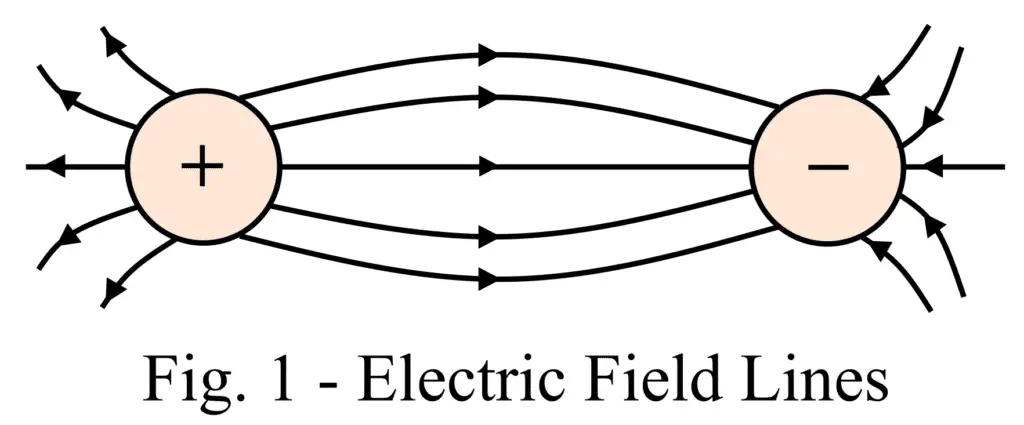
There are two types of electric fields depending on the magnitude and direction of an electric field.
Uniform Electric Field
When the magnitude and direction of the Electric field intensity remain the same at every point of the space, the electric field is said to be uniform. This condition is obtained by placing the current-carrying conductors parallel to each other as shown in Figure 2.
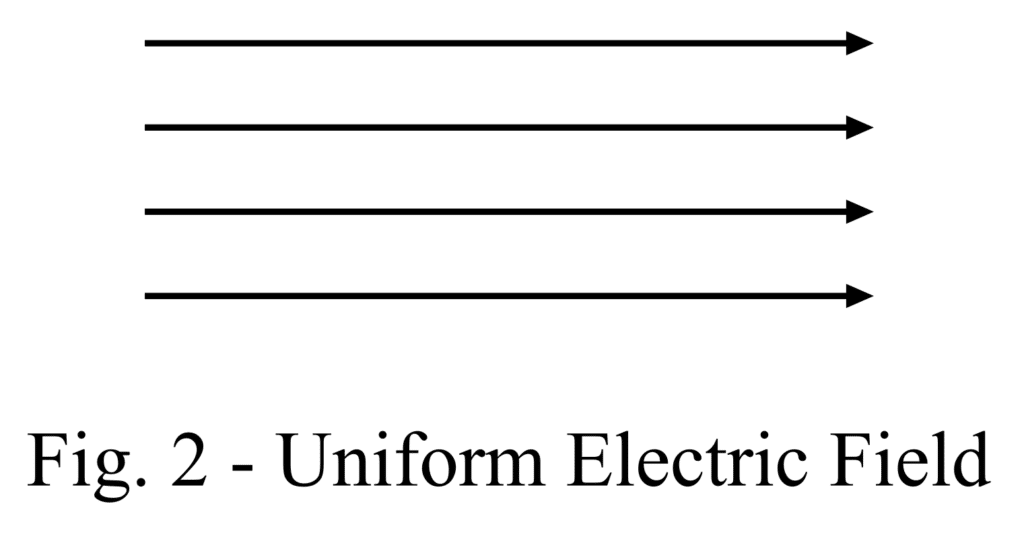
Non-Uniform Electric Field
When the magnitude and direction of the Electric field intensity vary and do not remain constant, the electric field is said to be non-uniform as shown in Figure 3.
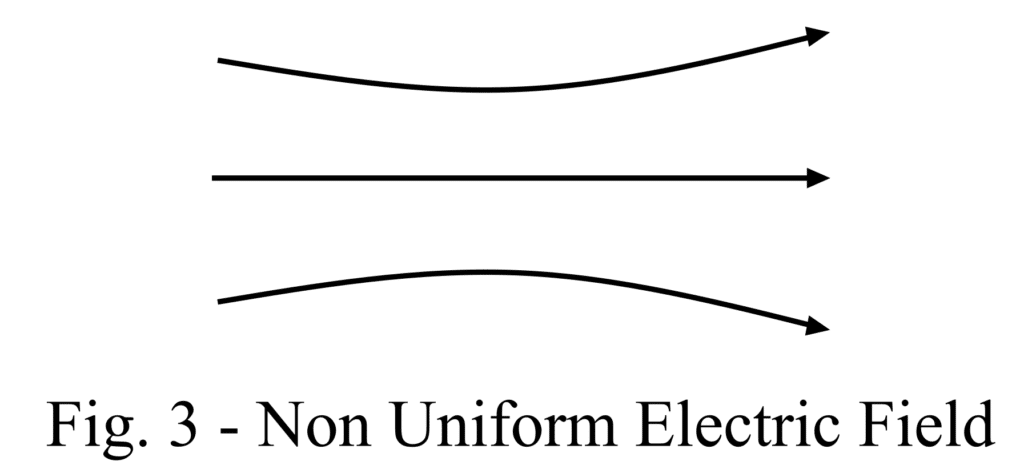
Characteristics of Electric Field
The electric field has the following characteristics:
- Electric Field lines do not overlap each other.
- The strength of the Electric field is determined by the degree of closeness of the electric field lines.
- The electric field lines are induced starting from the positively charged particle and ending at the negatively charged particle.
- The generated electric field is perpendicular to the electric charge produced.
What is Magnetic Field?
Magnetic Field is defined as the force generated in the area around a permanent magnet, starting from the magnet’s North Pole and ending at its south pole. The movement of electric charges across a current-carrying conductor also generates the magnetic field.
This phenomenon of the interrelation between electric and magnetic fields was discovered by a Danish physicist, Hans Christian Oersted in 1820. Figure 4 shows the magnetic field lines produced by a permanent magnet. The magnetic field is denoted by the symbol B with the SI unit of Newton per meter (N/m) or Tesla.
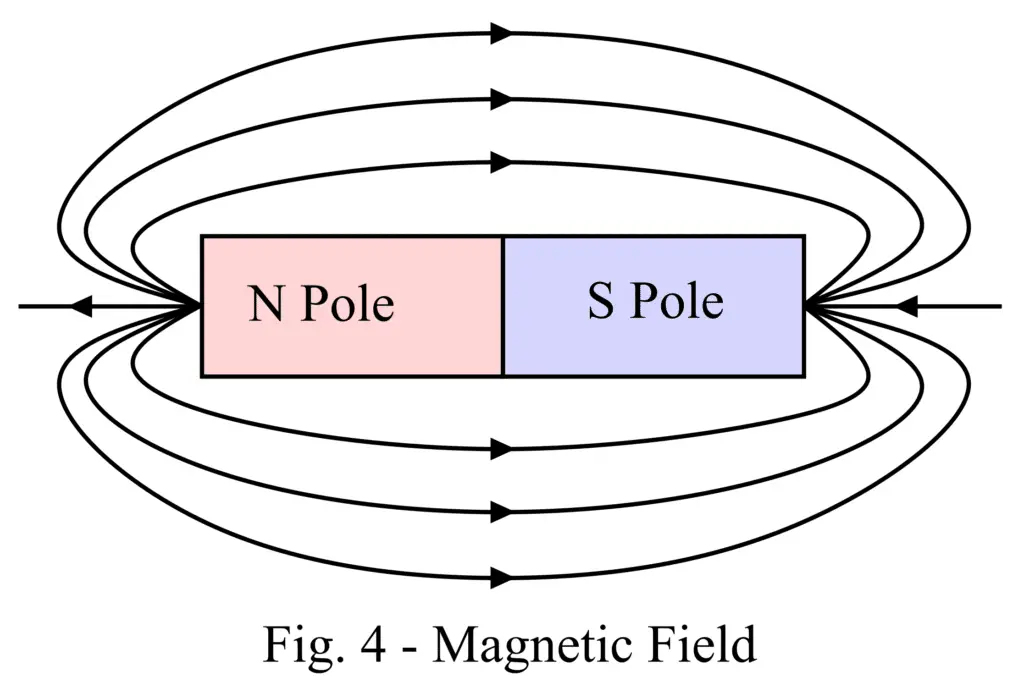
A moving charge always has both a magnetic and an electric field, which is precisely why they are interrelated in a field called the electromagnetic field. They are two different fields with nearly the same characteristics.
In the electromagnetic field, the electric field and the magnetic field always move at right angles to each other. However, their existence does not depend on each other. The electric field may exist without a magnetic field and the magnetic field may exist without an electric field. The magnetic field exists in permanent magnets without the electric field, and electric fields exist in static charges without the magnetic field.
Based on the source of origin, the magnetic field can be divided into the following two categories:
- Magnet-based Magnetic Field – generated by a permanent magnet.
- Current-based Magnetic Field – generated by current flowing across a conductor.
The formula of the magnetic field is;
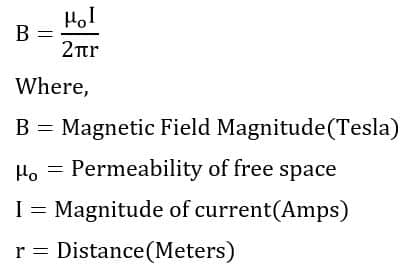
Characteristics of Magnetic Field
The Magnetic Field has the following characteristics:
- Magnetic field lines do not intersect each other at any point in the magnetic field region.
- The magnetic field lines begin from the North end of the magnet and end at the south end of it in the external of the magnet.
- The Magnetic Field lines begin from the south end of the magnet and end at the north end of it in the internal of the magnet.
- Magnetic field lines form enclosed loops surrounding the permanent magnet.
Relation between Electric Field and Magnetic Field formula
The electric field and magnetic field have a certain relationship and it can be expressed by a below given mathematical formula.

Difference between Electric Field and Magnetic Field
Although the phenomena of electric and magnetic fields are related to each other, there still exist notable differences between the two types of fields, which are listed in the table below.
| Key | Electric Field | Magnetic Field |
| Definition | The electric field is defined as the force experienced around electrically charged particles called electrons or protons. | The magnetic field is defined as the region of magnetic flux around a permanent magnet. |
| Cause | The electric field is generated by the movement of electrons across the current-carrying conductor. | The magnetic field is induced by a permanent magnet or by the movement of electric charge across a conductor. |
| Field Lines | Electric field lines do not form a closed loop. | Magnetic field lines form a closed loop starting from the north pole and ending at the magnet’s south pole. |
| Force | Proportional to electric charge | Proportional to charge and speed of electric charge. |
| Field Strength | The closer the electric field lines are to each other, the greater the Electric field intensity. | The closer the magnetic field lines are to each other, the greater the magnetic field strength. |
| Types | There are two types of electric fields namely uniform electric field and non-uniform electric field. | There are two types of magnetic fields namely magnet-based magnetic field and current-based magnetic field. |
| Symbol and Unit | The electric field is denoted by E and has a unit of Newton per Coulomb (N/C). The other unit of electric field is Volt/meter | The magnetic field is denoted by B and has a unit of Tesla (T) or Weber per square meter (Wb/m2). |
| Formula | The electric field is given by the following formula, E=F/Q, Where F is the Force in Newton, C is the charge in Coulomb. | The magnetic field is given by the following formula, B=Φ/A, Where Φ is magnetic flux, A is the area of cross-section. |
| Movement In Electromagnetic field | It is perpendicular to the magnetic field. | It is perpendicular to the electric field. |
| Electromagnetic Field | Generates VARS (Capacitive) | Absorbs VARS (Inductive) |
| Type of Pole | The electric field is a monopole as it is generated by a single electrically charged particle like an electron, or proton. | The magnetic field is a dipole as it is generated by two poles namely the north and south poles of the magnet. |
| Measuring Tool | Electrometer is used to measure the intensity of the electric field produced by the current-carrying conductor. | A magnetometer is used to measure the magnitude and direction of the magnetic field. |
| Applications | The electric field finds its applications in kitchen equipment, radio transmitters, and headphones. Power air conditioners, Television, computers, etc. | The magnetic field is used in a variety of applications such as in electric motors and generators, transformers, tape recorders, and electromagnets. |
Conclusion
Electric and magnetic fields are phenomena that are closely linked to each other in terms of the way they are generated. It can be concluded from this article that the most significant difference between Electric and Magnetic fields is that an electric field is produced by static electrically charged particles with no movement, on the other hand, a magnetic field is generated by the rapid movement of electrically charged particles. Thus, a changing electric field produces a magnetic field, and a changing magnetic field produces an electric field.